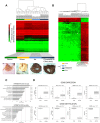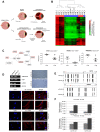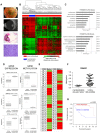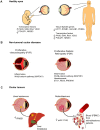DNA Methylomes Reveal Biological Networks Involved in Human Eye Development, Functions and Associated Disorders
- PMID: 28924151
- PMCID: PMC5603607
- DOI: 10.1038/s41598-017-12084-1
DNA Methylomes Reveal Biological Networks Involved in Human Eye Development, Functions and Associated Disorders
Abstract
This work provides a comprehensive CpG methylation landscape of the different layers of the human eye that unveils the gene networks associated with their biological functions and how these are disrupted in common visual disorders. Herein, we firstly determined the role of CpG methylation in the regulation of ocular tissue-specification and described hypermethylation of retinal transcription factors (i.e., PAX6, RAX, SIX6) in a tissue-dependent manner. Second, we have characterized the DNA methylome of visual disorders linked to internal and external environmental factors. Main conclusions allow certifying that crucial pathways related to Wnt-MAPK signaling pathways or neuroinflammation are epigenetically controlled in the fibrotic disorders involved in retinal detachment, but results also reinforced the contribution of neurovascularization (ETS1, HES5, PRDM16) in diabetic retinopathy. Finally, we had studied the methylome in the most frequent intraocular tumors in adults and children (uveal melanoma and retinoblastoma, respectively). We observed that hypermethylation of tumor suppressor genes is a frequent event in ocular tumors, but also unmethylation is associated with tumorogenesis. Interestingly, unmethylation of the proto-oncogen RAB31 was a predictor of metastasis risk in uveal melanoma. Loss of methylation of the oncogenic mir-17-92 cluster was detected in primary tissues but also in blood from patients.
Conflict of interest statement
The authors declare that they have no competing interests.
Figures






Similar articles
-
MicroRNA-124a is epigenetically regulated and acts as a tumor suppressor by controlling multiple targets in uveal melanoma.Invest Ophthalmol Vis Sci. 2013 Mar 1;54(3):2248-56. doi: 10.1167/iovs.12-10977. Invest Ophthalmol Vis Sci. 2013. PMID: 23404119
-
ETS-1 and ETS-2 are upregulated in a transgenic mouse model of pigmented ocular neoplasm.Mol Vis. 2008;14:1912-28. Epub 2008 Oct 29. Mol Vis. 2008. PMID: 18958307 Free PMC article.
-
[Progresses of DNA methylation in common ocular tumor].Zhonghua Yan Ke Za Zhi. 2015 Dec;51(12):950-4. Zhonghua Yan Ke Za Zhi. 2015. PMID: 26888278 Review. Chinese.
-
Impaired expression and promotor hypermethylation of O6-methylguanine-DNA methyltransferase in retinoblastoma tissues.Invest Ophthalmol Vis Sci. 2002 May;43(5):1344-9. Invest Ophthalmol Vis Sci. 2002. PMID: 11980845
-
Gene methylation in gastric cancer.Clin Chim Acta. 2013 Sep 23;424:53-65. doi: 10.1016/j.cca.2013.05.002. Epub 2013 May 10. Clin Chim Acta. 2013. PMID: 23669186 Review.
Cited by
-
Integrative Computational Approach Revealed Crucial Genes Associated With Different Stages of Diabetic Retinopathy.Front Genet. 2020 Nov 12;11:576442. doi: 10.3389/fgene.2020.576442. eCollection 2020. Front Genet. 2020. PMID: 33304382 Free PMC article.
-
Differential methylation in rare ophthalmic disorders: a systematic review protocol.Syst Rev. 2019 Apr 10;8(1):93. doi: 10.1186/s13643-019-0999-3. Syst Rev. 2019. PMID: 30971311 Free PMC article.
-
DNA methylation in diabetic retinopathy: pathogenetic role and potential therapeutic targets.Cell Biosci. 2022 Nov 17;12(1):186. doi: 10.1186/s13578-022-00927-y. Cell Biosci. 2022. PMID: 36397159 Free PMC article. Review.
-
A Review of MicroRNA in Uveal Melanoma.Onco Targets Ther. 2020 Jul 1;13:6351-6359. doi: 10.2147/OTT.S253946. eCollection 2020. Onco Targets Ther. 2020. PMID: 32669855 Free PMC article. Review.
-
Identification of Epigenetically Modified Hub Genes and Altered Pathways Associated With Retinoblastoma.Front Cell Dev Biol. 2022 Mar 10;10:743224. doi: 10.3389/fcell.2022.743224. eCollection 2022. Front Cell Dev Biol. 2022. PMID: 35359459 Free PMC article.
References
Publication types
MeSH terms
Substances
LinkOut - more resources
Full Text Sources
Other Literature Sources
Medical
Molecular Biology Databases
Miscellaneous

